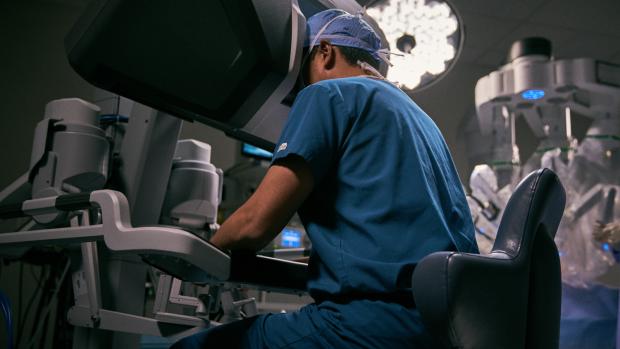Telerobotic surgery comes to NYU Tandon
With a major equipment donation, Tandon is now one of few institutions with access to “open source” research kit for da Vinci Surgical Robotic System

Leader-Follower teleoperated robotic systems have attracted a great deal of interest, and the market for them is projected to see steady growth, as they confer on surgeons augmented sensorimotor competence, leading to greater surgical safety and better outcomes. Additionally, and perhaps especially important because of COVID-19, they physically separate operating physicians from patients, minimizing risk of infection transfer.
While these systems are currently operated on local networks, with the surgeon feet away from the patient in the same (or an adjacent room), advances in telecommunications from 5G to 6G and beyond offer the tantalizing prospect that procedures could one day be performed by a surgeon who is miles away from the operating theater, or in another part of the world, for that matter.
To help make that vision a reality, the Medical Robotics and Interactive Intelligent Technologies (MERIIT) Lab at NYU Tandon, which conducts research on human-centered robotics, human-machine interface, and human-AI collaboration, has received a major equipment donation from the Intuitive Foundation: a da Vinci Research Kit (dVRK). The research kit, an open-sourced version of the classic da Vinci Surgical System, manufactured by Intuitive Surgical Inc., comprises the surgeon's side robotic console with two 6-DOF robotic arms and a 3D video display; a stereo vision camera system and surgical endoscope; and a 2-arm patient's side robotic console.
The donation will allow the lab to implement, mobilize, and evaluate outcomes, algorithms, and intelligent architectures in the area of telerobotic surgery, helping to democratize access to the technology and skilled practice.
The MERIIT Lab, led by Assistant Professor S. Farokh Atashzar, a member of NYU WIRELESS, and NYU CUSP, aims to lead the charge not only in removing the barrier of distance between skilled surgeons and patients, but in developing haptic interfaces that let the surgeon, however far away they may be from the operating theater, physically perceive the smallest forces applied on the tissue during a remote and delicate operation. The work being done at MERIIT lab is just one example of the state-of-the-art robotic research at NYU Tandon.
Atashzar explained that remote telesurgery, which is closer to reality than many may think given the emergence of wireless networks with ultra-low latency and ultra-high reliability, could be a democratizing factor in medicine.
“It could create more access to surgical specialists,” he said. “The best surgeon for a given procedure, who happens to be in California, could conceivably operate on a patient in New York. It also means areas with limited access to healthcare, generally, could have access to specialized surgical procedures, and creates options for treatment in dangerous areas, battlefields, or even in space, if the surgeon is Earthbound.”
The MERIIT lab’s research using the granted system has three major pillars:
- MERIIT researchers will conduct cutting-edge research on surgical autonomy and shared autonomy, using the parts of the operation that can be shared between local machines and remote surgeons. This will be achieved using advanced robot learning algorithms and artificial intelligence being developed at MERIIT Lab @ NYU.
- The researchers will also develop novel fundamental algorithms that maximize the transparency, perception, and stability of telerobotic surgical systems, in the presence of communication latency, jitter, and packet loss. The team will develop nonlinear controllers to stabilize the networked leader-follower robotic systems; they will also generate artificial intelligence that can compensate for the effect of degradations in QoS through adaptive computational modeling.
- They will develop multi-agent networked robotic systems to enable virtualized hand-over-hand training for novice surgeons under the guidance of an expert through shared virtual reality and telecommunication between multiple robots.
Atashzar said the goal of autonomous surgical systems is to improve the performance of remote human operators, at least initially. “We want to keep the surgeon in the loop, but with the goal of enabling different levels of shared autonomy between human and machine intelligence,” he explained.
Meanwhile, networked robotic systems could make possible such pedagogical scenarios as surgical training in which the experienced surgeon uses such systems to teach multiple students (novice surgeons) who “would all be working under the guidance of that one expert surgeon performing a virtually/physically simulated surgery, from any location,” Atashzar said.





